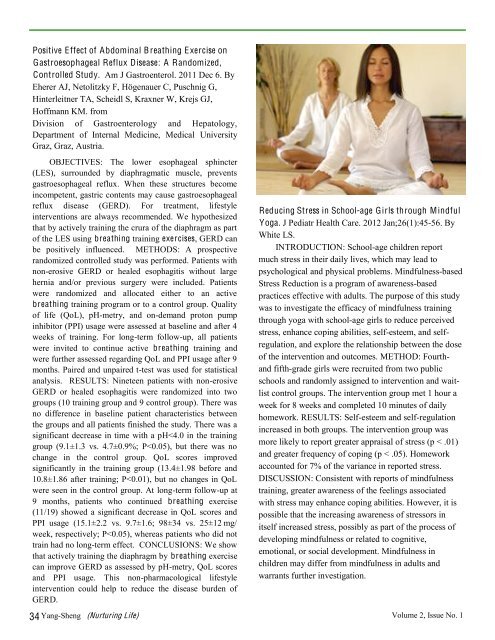Download PDF - Yang-Sheng
Download PDF - Yang-Sheng
Download PDF - Yang-Sheng
Create successful ePaper yourself
Turn your PDF publications into a flip-book with our unique Google optimized e-Paper software.
Positive Effect of Abdominal B reathing Exercise on<br />
Gastroesophageal Reflux Disease: A Randomized,<br />
Controlled Study. Am J Gastroenterol. 2011 Dec 6. By<br />
Eherer AJ, Netolitzky F, Högenauer C, Puschnig G,<br />
Hinterleitner TA, Scheidl S, Kraxner W, Krejs GJ,<br />
Hoffmann KM. from<br />
Division of Gastroenterology and Hepatology,<br />
Department of Internal Medicine, Medical University<br />
Graz, Graz, Austria.<br />
OBJECTIVES: The lower esophageal sphincter<br />
(LES), surrounded by diaphragmatic muscle, prevents<br />
gastroesophageal reflux. When these structures become<br />
incompetent, gastric contents may cause gastroesophageal<br />
reflux disease (GERD). For treatment, lifestyle<br />
interventions are always recommended. We hypothesized<br />
that by actively training the crura of the diaphragm as part<br />
of the LES using breathing training exercises, GERD can<br />
be positively influenced. METHODS: A prospective<br />
randomized controlled study was performed. Patients with<br />
non-erosive GERD or healed esophagitis without large<br />
hernia and/or previous surgery were included. Patients<br />
were randomized and allocated either to an active<br />
breathing training program or to a control group. Quality<br />
of life (QoL), pH-metry, and on-demand proton pump<br />
inhibitor (PPI) usage were assessed at baseline and after 4<br />
weeks of training. For long-term follow-up, all patients<br />
were invited to continue active breathing training and<br />
were further assessed regarding QoL and PPI usage after 9<br />
months. Paired and unpaired t-test was used for statistical<br />
analysis. RESULTS: Nineteen patients with non-erosive<br />
GERD or healed esophagitis were randomized into two<br />
groups (10 training group and 9 control group). There was<br />
no difference in baseline patient characteristics between<br />
the groups and all patients finished the study. There was a<br />
significant decrease in time with a pH













